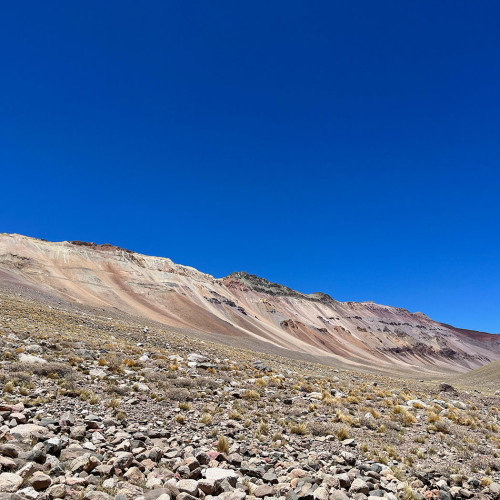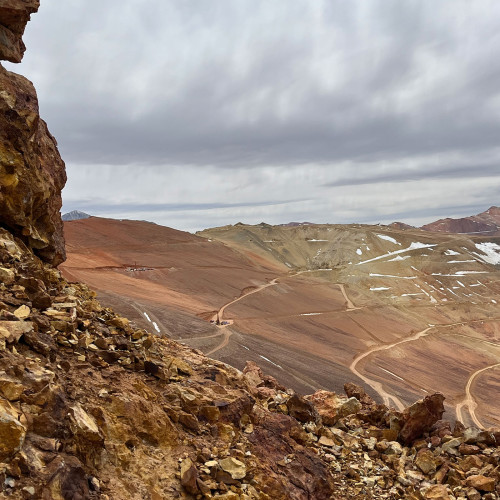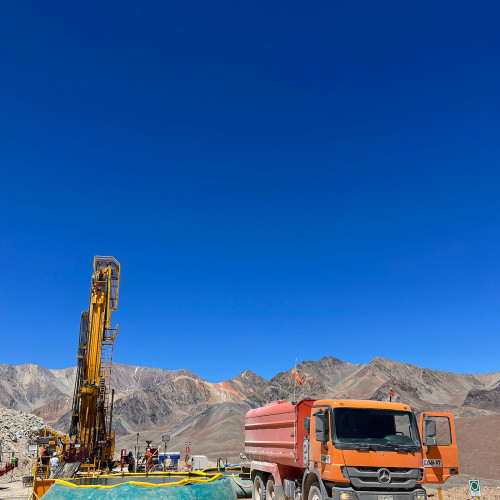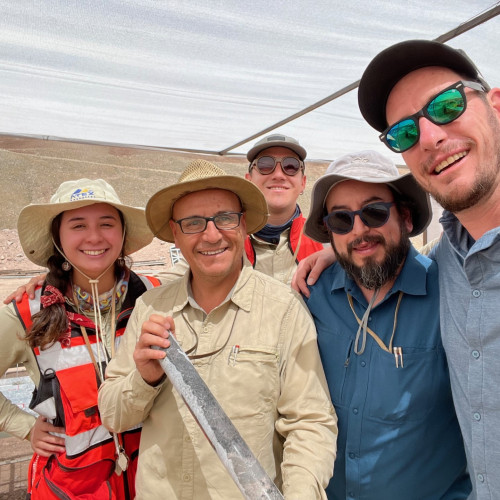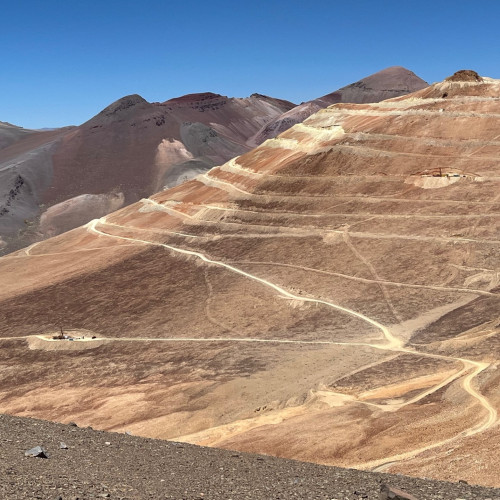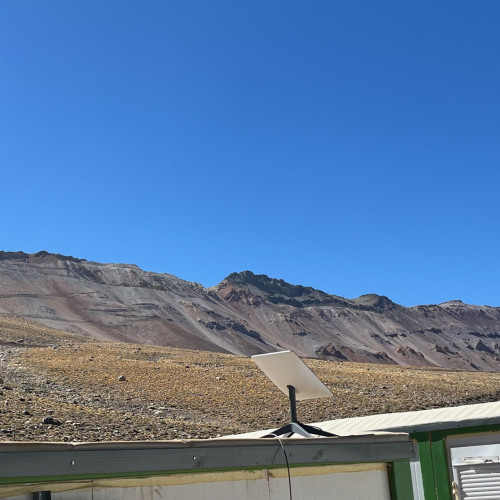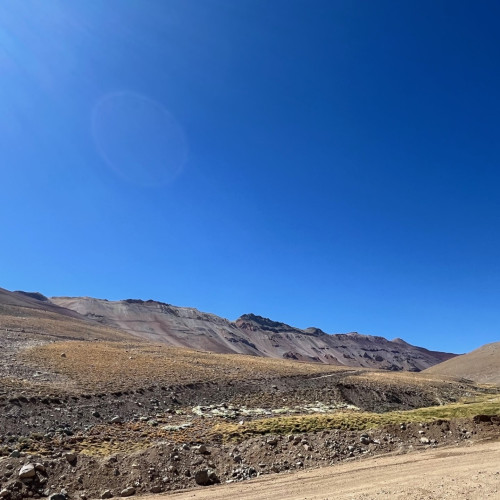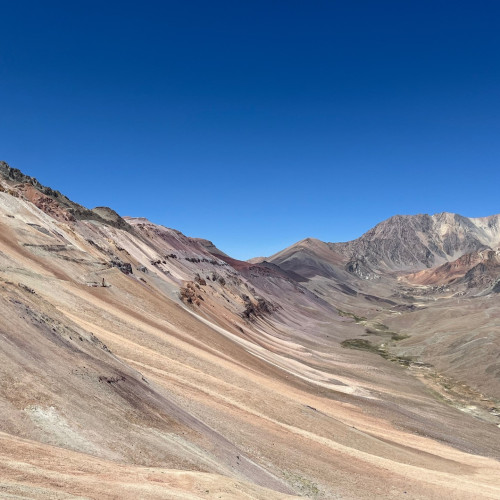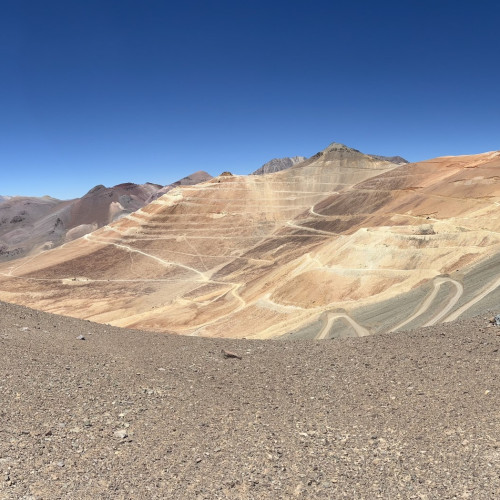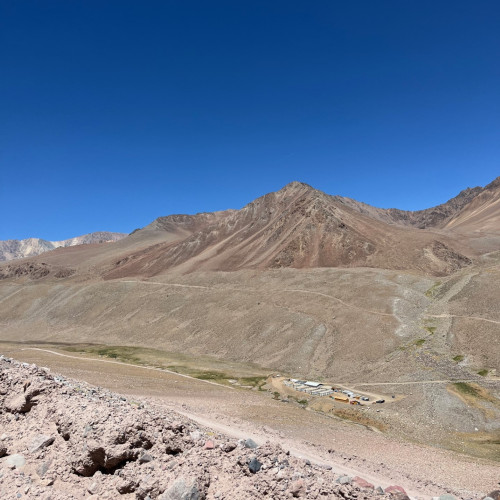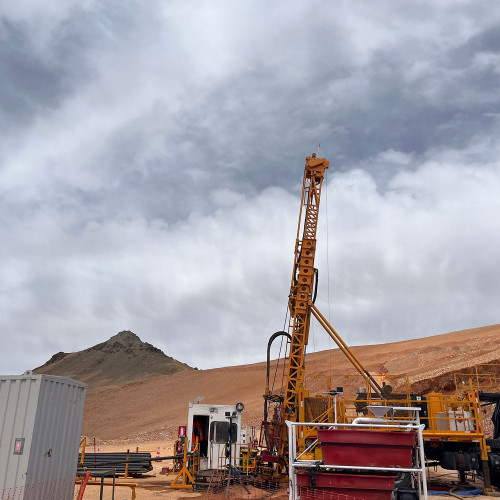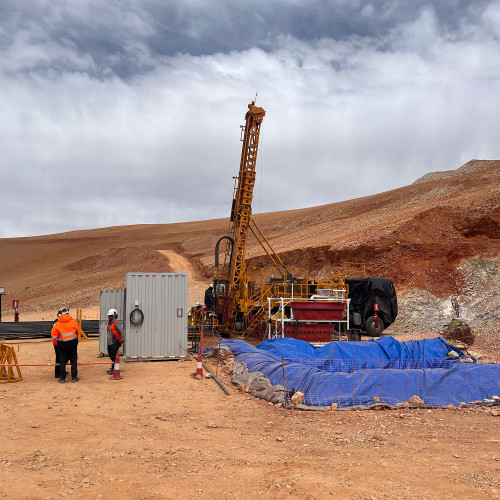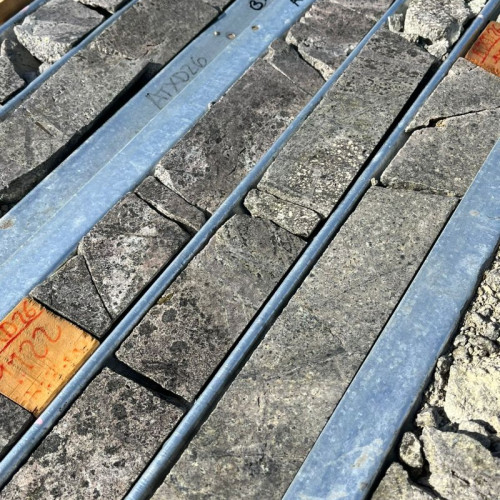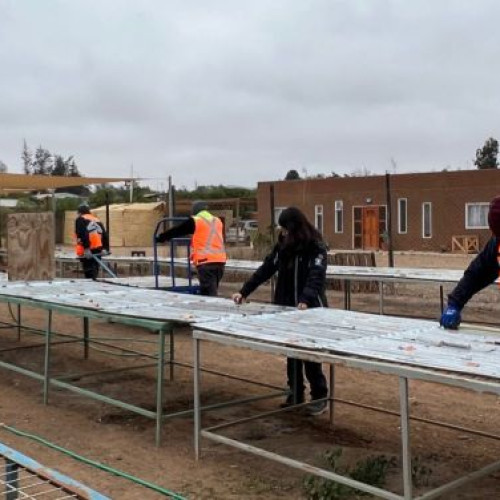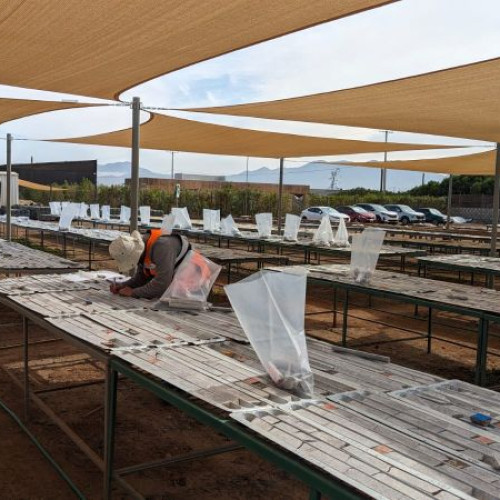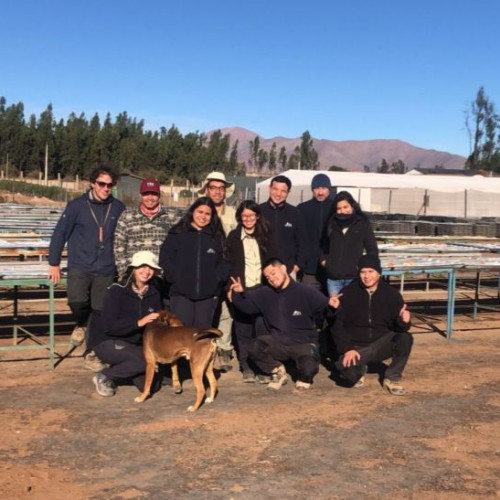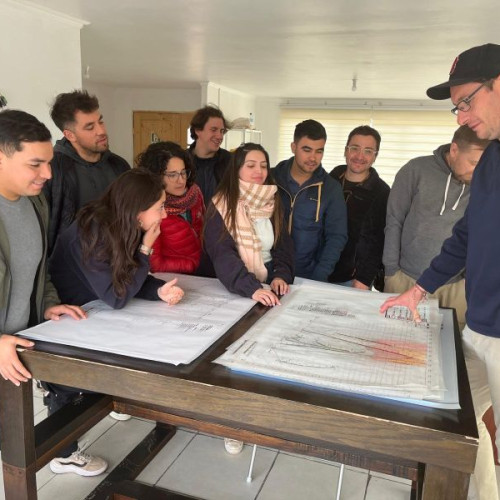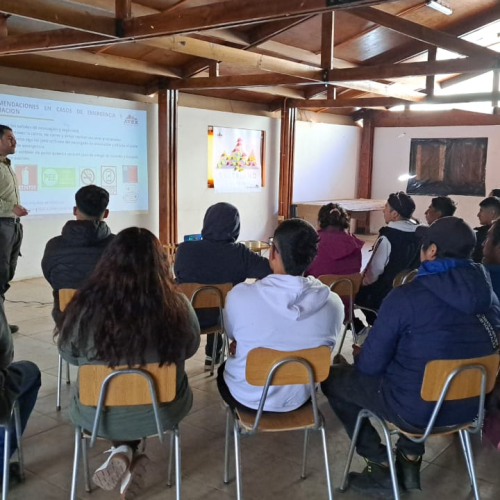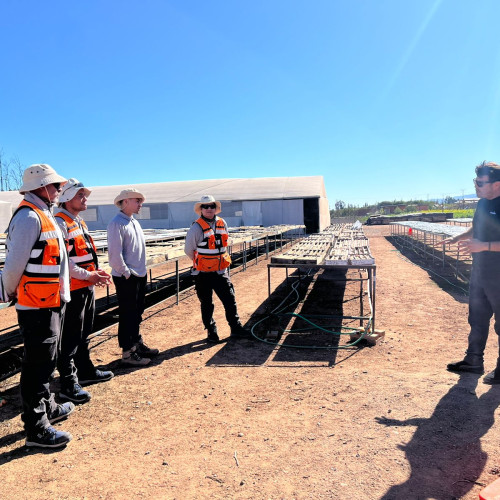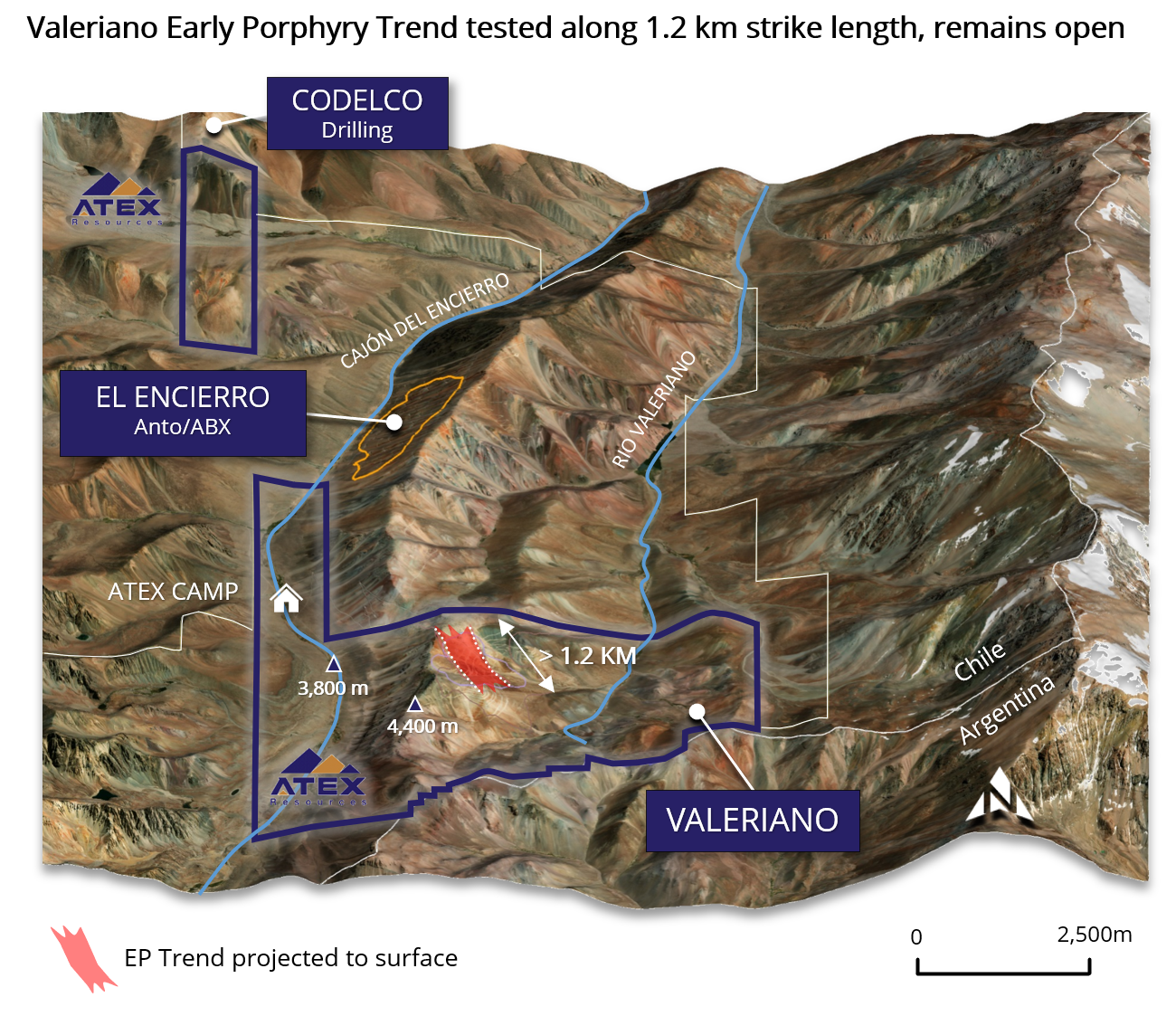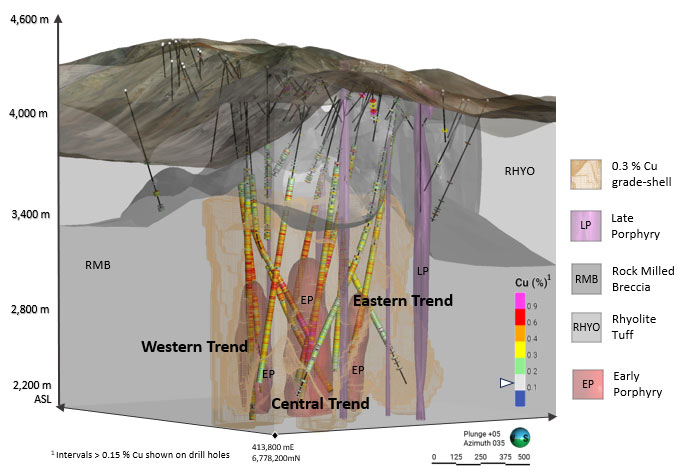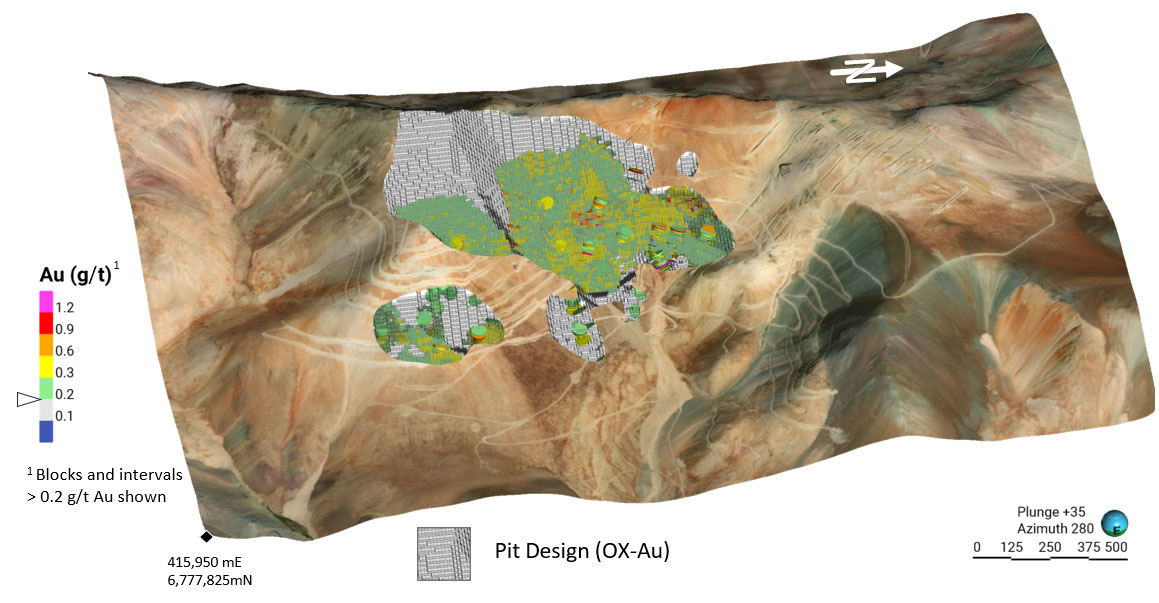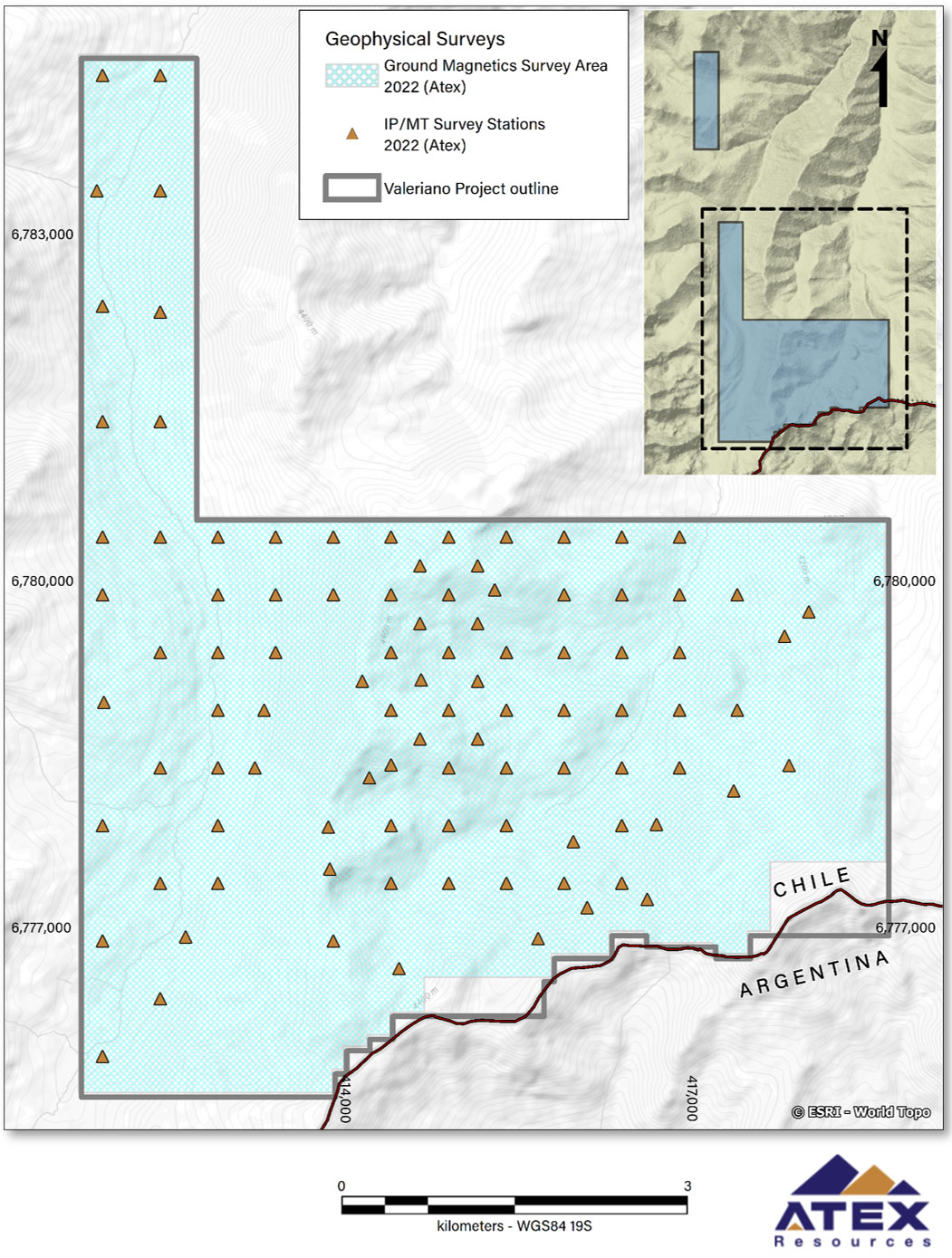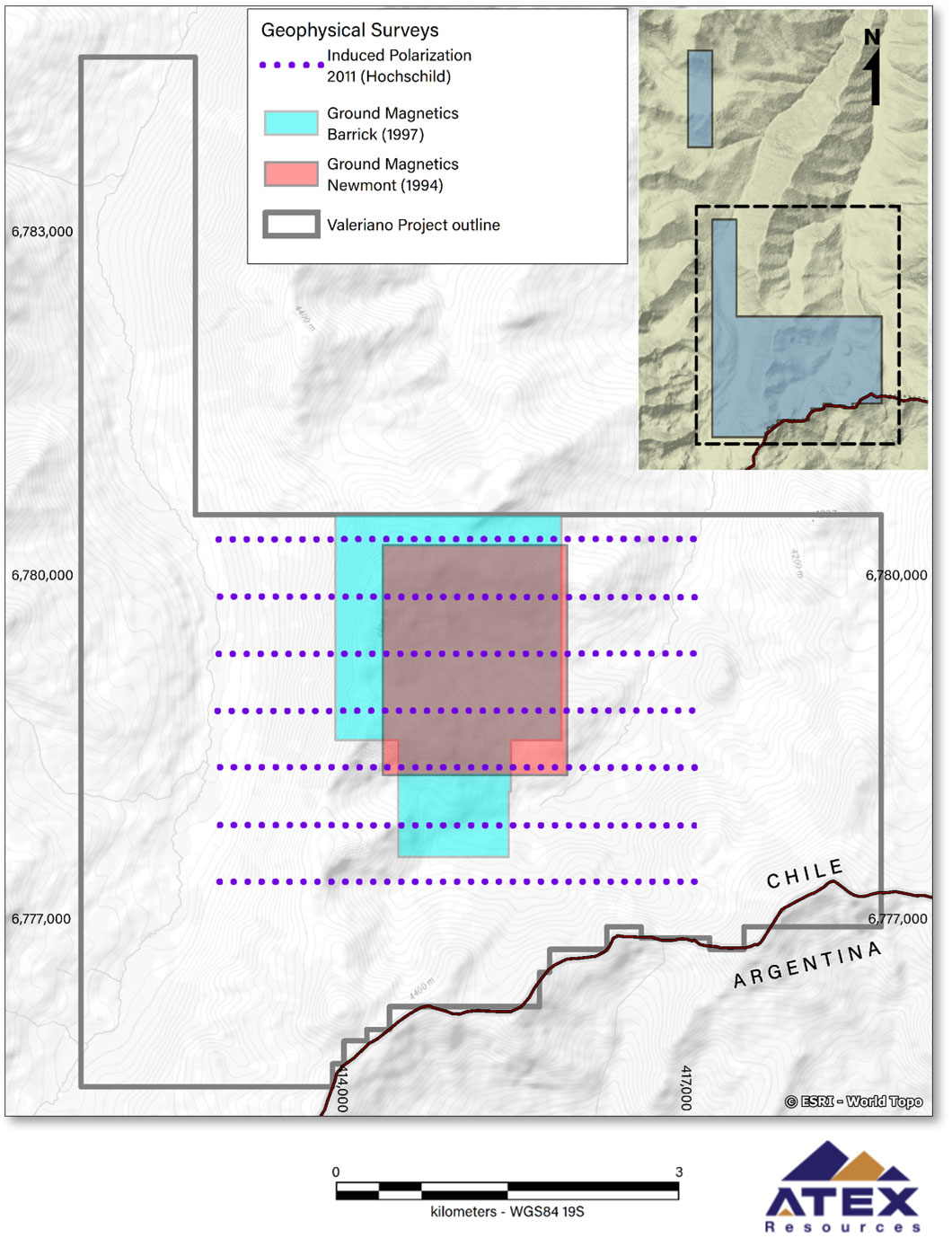I agree to and consent to receive news, updates, and other communications by way of commercial electronic messages (including email) from ATEX Resources. I understand I may withdraw consent at any time by clicking the unsubscribe link contained in all emails from ATEX Resources.
The Valeriano Project, located in the Huasco Province of the Atacama Region of northern Chile, is situated approximately 151 kilometres southeast of the City of Vallenar. Following the addition of 2,331 hectares of exploration concessions in 2023, the Property consists of 15 exploitation concessions and 14 exploration concessions covering a total area of 6,126 hectares.
The Project’s eastern and southern boundaries are formed by the Chilean border with Argentina and the concessions fall entirely within Chile. The Valeriano Project hosts a large copper gold porphyry deposit, below a near surface oxidized epithermal gold deposit that extends from surface to a depth of 100 metres1.
In 2023, ATEX reported updated mineral resources for both the oxide gold deposit and copper gold porphyry1.
In 2022, Phase II drilling was the company’s first test of the porphyry system with two drill holes (ATXD17 and ATXD192) targeting the high-grade central trend, initially intersected by Hochschild drill hole VALDD-14. Both drill holes intersected significant mineralization confirming proof of concept for the potential of a higher-grade core of ≥0.8% CuEq within the Central High-Grade Trend at Valeriano.
In 2022-2023 Phase III drilling utilized directional drilling to expand on the successes of Phase II and reduce costs by re-entering historical drill holes and drilling daughter holes from depth. The Program has successfully expanded the mineralized corridor within the Valeriano project, extended the high-grade (≥0.8% CuEq) core and discovered a third porphyry trend to the west of the Central Trend.
Phase III drilling further bolstered ATEX’s proof of concept and intersected the project’s longest intersections to date in eight drill holes (ATXD11A3, ATXD214, ATXD11B5, ATXD225, ATXD22A6, ATXD236, ATXD22B7 and ATXD247).
2023-2024 Phase IV drilling again utilized directional drilling to realize the successes of past programs. ATEX has vastly improved the understanding of the geometry of the Valeriano system and demonstrated more continuity of the higher-grade core by intersecting the best grades seen on the Project to date. At the end of the campaign, the system remained open in all directions despite increasing the strike length on the mineralized intrusive units to over 1.2 kilometers demonstrating potential for scalability of the deposit. Additionally, the late-stage epithermal system overprinting wall rock mineralization that was intersected above the top of the porphyry units provides another exciting exploration target to follow up on in Phase V and represents potential optionality as a separate high-grade domain within the greater resource envelope and higher up in the system. Assay results from 8 drill holes were released (ATXD12A8, ATXD16A9, ATXD17A9, ATXD2510, ATXD17B11, ATXD2611, ATXD25A12, and ATXD26A12). Drill holes ATXD25A, ATXD26A, and ATXD2712 were paused at the completion of Phase IV and will be re-entered during the Phase V program.
Based on the option agreement originally signed in August 2019, and amended in January 2020 and August 2023, ATEX can earn a 100% interest in Valeriano by September 1, 2025. For details of the payments and work commitments, please see the company's corporate presentation.
1 For further information, please see ATEX’s NI 43-101 compliant technical report titled “Independent Technical Report for the Valeriano Copper-Gold Project, Atacama Region, Chile” with an effective date of September 1, 2023, prepared for ATEX by SRK Consulting (Chile) SpA. A copy of the foregoing technical report is available on ATEX’s website and also under ATEX’s SEDAR+ profile at www.sedarplus.com. As set out in the foregoing technical report, Copper Equivalent (CuEq) is calculated assuming US$ 3.15/lb copper (Cu), US$ 1,800/oz gold (Au), US$ 23/oz Silver (Ag), and US$ 20/lb Molybdenum (Mo) and metallurgical recoveries of 90% for Cu, 70% for Au, 80% for Ag, and 60% for Mo using the formula CuEq % = Cu % + (6481.488523 * Au g/t) + (94.6503085864 * Ag g/t) + (4.2328042328 * Mo g/t).
2 For ATXD17 and ATXD19 results, procedures and QA/QC information, see press release from June 13, 2022.
3 For ATXD11A results, procedures and QA/QC information, see press release from February 7, 2023.
4 For ATXD21 results, procedures and QA/QC information, see press release from February 27, 2023.
5 For ATXD11B and ATXD22 results, procedures and QA/QC information, see press release from March 30, 2023.
6 For ATXD22A and ATXD23 results, procedures and QA/QC information, see press release from June 5, 2023.
7 For ATXD22B and ATXD24 results, procedures and QA/QC information, see press release from July 13, 2023.
8 For ATXD16A, ATXD17A, ATXD12A, ATXD25, AXTD17B, ATXD26, ATXD25A, ATXD26A and ATXD27 results, procedures and QA/QC information, see press release from June 25, 2024.
Phase I Drill Campaign
In early 2021, ATEX completed a 1,708 metre Reverse Circulation “RC” program (Phase I) with the goal of exploring the potential of the epithermal gold oxide deposit.
Phase II Drill Campaign
In 2022, ATEX completed its initial drill program designed to follow up on and expand the copper-gold porphyry-style mineralization at depth at Valeriano. This mineralization was initially encountered by the previous operator in 2013. The Phase II program was designed to further define and extend high-grade copper-gold mineralization intersected in hole VALDD13-0141, which returned 1,194 metres of 0.73% CuEq (0.52% Cu, 0.24 g/t Au and 36ppm Mo), including 1.00% CuEq (0.72% Cu, 0.28 g/t Au and 21 ppm Mo) over 272 metres. ATEX drill holes following up on this hole, ATXD172 and ATXD192, were drilled as 200 metre step outs to the southwest and northeast, respectively to test the high-grade extension.
ATXD17, the most impressive from the Phase II program at Valeriano, was reported on June 13, 2022. This hole was drilled 200 metres southwest of VALDD13-014 and demonstrated the continuity of the high-grade target zone, intersecting 1,160 metres of 0.78% CuEq (0.53% Cu, 0.28 g/t Au, 70ppm Mo), including 1.03% CuEq (0.69% Cu, 0.39g/t Au, 70ppm Mo) over 550 metres. Hole ATXD19, collared 200 metres northeast of VALDD13-014 and lost at a depth of 1,309 metres due to operational issues, did not reach the high-grade target zone. Despite not reaching its target depth, ATXD19 intersected 647 metres of 0.65% CuEq (0.5% Cu, 0.15 g/t Au, 60ppm Mo), establishing continuity of copper gold mineralization a further 200 metres to the northeast.
Phase III Drill Campaign
The Phase III, 2022-2023 exploration program commenced in October 2022 with the goal of extending the high-grade trend intersected in holes ATXD17 and VALDD13-014. The program successfully concluded in late May 2023. The realized objectives of the program were:
- expanding the mineralized footprint,
- the discovery of an additional trend (Western Trend)
This program was ATEX’s first drill campaign at Valeriano utilizing directional drilling, which allowed for the testing of multiple targets off a single hole. Using this approach maximized the efficiency of the programme and will continue to be utilized in future phases of exploration to reduce costs and deliver results to market more quickly.
Phase III drilling commenced in October 2022 and included eight diamond drill holes (four from surface and four daughter holes) totaling 12,512.9 metres. The Phase III campaign was developed with the intention of expanding the mineralized corridor through step out drilling along strike, primarily to the northeast as well as testing new targets along this corridor and seeking to define the continuity and geometry of the high-grade trend intersected in Phase II.
As part of this program, historical drill hole VALDD12-011 was re-entered from surface and two directional daughter holes, ATXD11A3 and ATXD11B5, were drilled from starting depths of 855.0 metres and 697.0 metres respectively. Additional directional daughter holes were completed from ATXD226, with ATXD22A6 starting at 921.35 metres and ATXD22B7 starting at 444.3 metres.
Holes from drilled from surface in Phase III included, ATXD214, ATXD22 (mother), ATXD236 and ATXD247.
Phase IV Drill Campaign
Approximately 12,000m of diamond drilling was completed in the Phase IV drill program, started in October 2023, and concluded in May 2024. The goals of the Phase IV program were to to further define and extend the high-grade porphyry trends intersected in Phase II and III and explore beyond the defined dimensions of the mineralized corridor.
ATEX continued to use directional diamond drilling in the Phase IV program, which allowed the company to realize an effective total of 20,100m drilled in the event all holes had been drilled from surface.
Four daughter holes - ATXD12A, ATXD16A, ATXD17A, ATXD17B - and two mother holes - ATXD25 and ATXD26 - were completed in the Phase IV program, with an additional two daughter holes and one mother hole partially completed - ATXD25A, ATXD26A and ATXD27 - were paused at the end of Phase IV8.
Summaries of highlighted results for Phases I-IV are presented on the map in Figure 1 with ATEX results in Tables 1, 2 and 4.
Figure 1. ATEX and Historical Drilling at Valeriano
Table 1. Summary of Significant Copper-Gold Porphyry Assay Results
| Operator | Phase | Hole ID | From | To | Interval | Cu | Au | Ag | Mo | CuEq(1) | Length |
|---|---|---|---|---|---|---|---|---|---|---|---|
| (m) | (m) | (m) | (%) | (g/t) | (g/t) | (ppm) | (%) | (m) | |||
| Hochschild | VALDD12-009 | 898.0 | 1,750.0 | 852.0 | 0.47 | 0.16 | 0.75 | 89 | 0.64 | 1,878.00 | |
| VALDD12-012 | 1,012.0 | 1,056.0 | 44.0 | 0.30 | 0.16 | 0.47 | 110 | 0.48 | 1,058.00 | ||
| VALDD13-014 | 614.0 | 1,808.0 | 1,194.0 | 0.52 | 0.24 | 1.01 | 36 | 0.73 | 1,845.00 | ||
| incl. | 1,420.0 | 1,692.0 | 272.0 | 0.72 | 0.28 | 1.52 | 21 | 1.00 | |||
| VALDD13-016 | 576.0 | 1,621.0 | 1,045.0 | 0.39 | 0.17 | 0.73 | 54 | 0.54 | 1,621.00 | ||
| ATEX | Phase II | ATXD17 | 802.0 | 1,962.0 | 1,160.0 | 0.53 | 0.28 | 1.10 | 70 | 0.78 | 2,057.00 |
| incl. | 1,280.0 | 1,830.0 | 550.0 | 0.69 | 0.39 | 1.30 | 70 | 1.03 | |||
| ATXD19 | 662.0 | 1,309.0 | 647.0 | 0.50 | 0.15 | 0.84 | 60 | 0.65 | 1,309.00 | ||
| Phase III | ATXD11A | 860.0 | 2,130.1 | 1,270.1 | 0.43 | 0.21 | 0.13 | 52 | 0.63 | 2,130.00 | |
| incl. | 1,048.0 | 1,213.4 | 165.4 | 0.51 | 0.20 | 0.85 | 105 | 0.73 | |||
| and | 1,376.0 | 1,492.4 | 116.4 | 0.56 | 0.30 | 1.48 | 95 | 0.82 | |||
| Incl. | 1,376.0 | 1,393.3 | 17.3 | 0.73 | 0.30 | 1.15 | 39 | 1.01 | |||
| and incl. | 1,450.0 | 1,470.0 | 20.0 | 0.64 | 0.30 | 2.00 | 308 | 1.06 | |||
| and | 1,698.0 | 2,130.1 | 432.1 | 0.48 | 0.30 | 1.95 | 12 | 0.71 | |||
| incl. | 1,698.0 | 1,868.0 | 170.0 | 0.54 | 0.30 | 2.41 | 11 | 0.81 | |||
| also incl. | 1,730.0 | 1,752.0 | 22.0 | 0.66 | 0.40 | 3.25 | 11 | 0.95 | |||
| and | 1,816.7 | 1,836.0 | 19.3 | 0.56 | 0.50 | 2.63 | 10 | 0.94 | |||
| and | 1,854.0 | 1,868.0 | 14.0 | 0.60 | 0.50 | 2.79 | 11 | 1.00 | |||
| and | 2,100.0 | 2,130.1 | 30.1 | 0.53 | 0.20 | 1.67 | 19 | 0.73 | |||
| ATXD11B | 848.0 | 2,190.5 | 1,342.5 | 0.46 | 0.31 | 1.71 | 43 | 0.73 | 2,190.50 | ||
| incl. | 1,078.0 | 2,088.0 | 1,010.0 | 0.50 | 0.35 | 1.88 | 29 | 0.80 | |||
| incl. | 1,438.0 | 2,088.0 | 650.0 | 0.46 | 0.44 | 2.39 | 13 | 0.83 | |||
| incl. | 1,864.0 | 2,086.0 | 222.0 | 0.46 | 0.58 | 2.94 | 13 | 0.94 | |||
| incl. | 1,964.0 | 2,086.0 | 122.0 | 0.47 | 0.65 | 3.40 | 14 | 1.01 | |||
| ATXD21 | 846.0 | 1,274.0 | 428.0 | 0.31 | 0.20 | 0.67 | 56 | 0.48 | 1,838.00 | ||
| incl. | 850.0 | 902.0 | 52.0 | 0.34 | 0.20 | 0.56 | 73 | 0.53 | |||
| incl. | 1,020.0 | 1,044.0 | 24.0 | 0.32 | 0.20 | 0.95 | 38 | 0.52 | |||
| incl. | 1,084.0 | 1,252.0 | 168.0 | 0.41 | 0.20 | 0.76 | 60 | 0.59 | |||
| and | 1,492.0 | 1,532.0 | 40.0 | 0.27 | 0.10 | 0.46 | 68 | 0.41 | |||
| ATXD22 | 630.0 | 1,600.0 | 970.0 | 0.38 | 0.10 | 0.71 | 99 | 0.51 | 1,712.00 | ||
| incl. | 630.0 | 922.0 | 292.0 | 0.31 | 0.01 | 0.40 | 108 | 0.44 | |||
| incl. | 1,016.0 | 1,128.0 | 112.0 | 0.57 | 0.14 | 0.98 | 212 | 0.77 | |||
| and | 1,426.0 | 1,568.0 | 142.0 | 0.40 | 0.11 | 1.13 | 55 | 0.51 | |||
| ATXD23 | 782.0 | 1,746.0 | 964.0 | 0.48 | 0.24 | 1.14 | 78 | 0.70 | 2,050.50 | ||
| incl. | 1,130.0 | 1,732.0 | 602.0 | 0.50 | 0.37 | 1.43 | 11 | 0.80 | |||
| incl. | 1,612.0 | 1,732.0 | 120.0 | 0.45 | 0.54 | 2.18 | 3 | 0.90 | |||
| and | 1,858.0 | 2,050.1 | 192.1 | 0.24 | 0.40 | 1.71 | 4 | 0.56 | |||
| ATXD22A | 921.4 | 1,468.0 | 546.7 | 0.32 | 0.08 | 0.37 | 173 | 0.45 | 1,871.00 | ||
| ATXD24* | 1,173.0 | 1,842.4 | 669.4 | 0.60 | 0.24 | 0.93 | 101 | 0.84 | 1,842.40 | ||
| incl. | 1,173.0 | 1,530.0 | 357.0 | 0.50 | 0.18 | 0.77 | 121 | 0.70 | |||
| incl. | 1,530.0 | 1,842.4 | 312.4 | 0.70 | 0.30 | 1.11 | 77 | 1.00 | |||
| Phase IV | ATXD12A | 864 | 1986 | 1122 | 0.37 | 0.14 | 0.97 | 57 | 0.5 | 2,001.20 | |
| incl. | 1500 | 1986 | 486 | 0.36 | 0.17 | 1.4 | 21 | 0.52 | |||
| also incl. | 1648 | 1682 | 34 | 0.48 | 0.22 | 2.6 | 44 | 0.69 | |||
| and | 1890 | 1924 | 34 | 0.48 | 0.25 | 2.02 | 5 | 0.7 | |||
| ATXD16A | 950 | 1802 | 852 | 0.6 | 0.28 | 0.98 | 72 | 0.88 | 2,067.95 | ||
| incl. | 1168 | 1762 | 594 | 0.67 | 0.32 | 1.13 | 71 | 0.99 | |||
| incl. | 1616 | 1728 | 112 | 1.01 | 0.57 | 2.06 | 46 | 1.52 | |||
| ATXD17A | 1052 | 1976 | 924 | 0.45 | 0.17 | 0.88 | 99 | 0.65 | 2,027.00 | ||
| incl. | 1062 | 1555 | 493 | 0.5 | 0.21 | 0.82 | 113 | 0.74 | |||
| incl. | 1216 | 1314 | 98 | 0.56 | 0.28 | 0.9 | 103 | 0.85 | |||
| ATXD25 | 1346 | 2208.2 | 862.2 | 0.42 | 0.27 | 1.72 | 26 | 0.68 | 2,208.20 | ||
| incl. | 1550 | 2208.2 | 658.2 | 0.42 | 0.33 | 2.09 | 7 | 0.72 | |||
| and incl. | 1858 | 2208.2 | 350.2 | 0.45 | 0.42 | 2.6 | 3 | 0.82 | |||
| and incl. | 2084 | 2198 | 114 | 0.54 | 0.48 | 2.95 | 6 | 0.97 | |||
| ATXD17B | 750 | 1254 | 504 | 0.42 | 0.17 | 0.96 | 51 | 0.6 | 1,671.70 | ||
| ATXD26 | 586 | 1564 | 978 | 0.54 | 0.21 | 1.26 | 145 | 0.81 | 1,565.40 | ||
| incl. | 1010 | 1366 | 356 | 0.7 | 0.29 | 1.49 | 180 | 1.05 | |||
| and incl. | 1086 | 1208 | 122 | 1.11 | 0.49 | 2.71 | 348 | 1.73 | |||
| and incl. | 1100 | 1168 | 68 | 1.39 | 0.6 | 3.81 | 473 | 2.19 | |||
| ATXD25A* | 1230 | 1454.2 | 224.2 | 0.37 | 0.07 | 0.57 | 112 | 0.5 | 1,454.20 | ||
| ATXD26A* | 791.85 | 823.3 | 31.45 | 0.45 | 0.13 | 1.31 | 175 | 0.66 | 925.50 | ||
| ATXD27* | 0 | 944.3 | 944.3 | NSR | NSR | NSR | NSR | NSR | 944.30 | ||
Scroll right to view more
(1) CuEq values reflect those used in original press release results
*Holes ATXD25A, ATXD26A and ATXD27 were paused at end of Phase IV and will be re-entered during the Phase V program
Table 2. Summary Results for ATEX Phase I Near Surface Oxide Gold Drilling
| Hole ID | From | To | Interval | Au | Ag | Hole Length |
|---|---|---|---|---|---|---|
| (m) | (m) | (m) | (g/t) | (g/t) | (m) | |
| ATXR01 | 12 | 18 | 6 | 0.6 | 2.45 | 200 |
| and | 134 | 138 | 4 | 0.58 | 1.54 | |
| ATXR02 | 8 | 58 | 50 | 0.32 | 1.51 | 140 |
| incl. | 10 | 14 | 4 | 0.53 | 2.78 | |
| and | 50 | 58 | 8 | 0.47 | 1.29 | |
| ATXR03 | 0 | 8 | 8 | 0.46 | 2.19 | 120 |
| and | 26 | 76 | 50 | 0.68 | 2.18 | |
| incl. | 26 | 32 | 6 | 1.07 | 3.24 | |
| and | 50 | 74 | 24 | 0.81 | 2.42 | |
| ATXR04 | 6 | 14 | 8 | 0.26 | 0.69 | 170 |
| and | 20 | 40 | 20 | 0.36 | 1.04 | |
| incl. | 20 | 28 | 8 | 0.48 | 1.25 | |
| and | 58 | 64 | 6 | 0.27 | 1.1 | |
| and | 118 | 122 | 4 | 1.27 | 0.48 | |
| ATXR05 | 4 | 20 | 16 | 0.32 | 1.38 | 200 |
| and | 72 | 78 | 6 | 0.29 | 1.25 | |
| and | 82 | 100 | 18 | 0.46 | 1.33 | |
| incl. | 82 | 94 | 12 | 0.55 | 1.58 | |
| ATXR06 | 14 | 20 | 6 | 0.3 | 1.1 | 150 |
| and | 40 | 54 | 14 | 0.32 | 0.97 | |
| incl. | 44 | 52 | 8 | 0.43 | 1.23 | |
| and | 70 | 116 | 46 | 0.54 | 1.39 | |
| incl. | 100 | 108 | 8 | 1.48 | 4 | |
| ATXR07 | 6 | 14 | 8 | 0.58 | 2.4 | 114 |
| ATXR08 | 58 | 76 | 18 | 0.42 | 3.02 | 174 |
| incl. | 66 | 72 | 6 | 0.66 | 4.94 | |
| and | 88 | 92 | 4 | 0.81 | 6.89 | |
| and | 100 | 120 | 20 | 1.45 | 4.9 | |
| incl. | 106 | 118 | 12 | 2.25 | 7.24 | |
| and | 132 | 172 | 40 | 1.25 | 4.06 | |
| incl. | 132 | 140 | 8 | 2.98 | 14.17 | |
| and | 162 | 166 | 4 | 4.24 | 2.6 | |
| ATXR09 | 16 | 20 | 4 | 0.7 | 5.51 | 96 |
| and | 26 | 38 | 12 | 0.3 | 1.34 | |
| and | 46 | 56 | 10 | 0.82 | 4.7 | |
| incl. | 46 | 52 | 6 | 1.19 | 6.85 | |
| and | 74 | 92 | 18 | 0.37 | 2.17 | |
| incl. | 82 | 92 | 10 | 0.43 | 2.85 | |
| ATXR10 | 2 | 8 | 6 | 0.29 | 1.55 | 140 |
| ATXR11 | 12 | 18 | 6 | 0.4 | 0.72 | 130 |
| ATXR12 | 10 | 46 | 36 | 0.49 | 0.41 | 72 |
| incl. | 10 | 16 | 6 | 0.99 | 1.13 | |
| and | 28 | 38 | 10 | 0.67 | 0.24 | |
| and | 58 | 72 | 14 | 0.39 | 0.13 |
Scroll right to view more
Exploration pre-ATEX
Exploration at Valeriano commenced in the 1980’s. Initial regional exploration, consisting of outcrop and float sampling, returned anomalous results followed by the acquisition of the concessions by the vendor. Further sampling and trenching was carried out through the 1980’s and into the 1990’s, targeting the near surface alteration features. Through the 1990’s, various drill campaigns were completed by three operators, Phelps Dodge (1989-1991), Barrick (1995-1997) and Hochschild (2011-2013). The initial focus of exploration was on the near-surface oxide gold potential, transitioning to a focus on the porphyry potential by 2013. To date, 32,365 metres in in 78 holes (20,982 metres of diamond drill core and 11,383 metres of RC drilling) have been completed on the property. Work by historical operators is summarized below in Table 3.
Table 3. Historical Exploration Activities
| Company | Period | Surface samples | Trenching (m) | Geophysics IP (Km) | Geophysics Mag (Km) | Mapping | Special Studies* |
|---|---|---|---|---|---|---|---|
| J. Ambrus | 1986 | 107 | ✓ | ||||
| Rayrock | 1988 | 403 | 720 | ✓ | ✓ | ||
| Phelps Dodge | 1989-1991 | 27 | 961 | ✓ | |||
| Newmont | 1993-1994 | 450 | 32 | ✓ | ✓ | ||
| Barrick | 1995-1997 | 693 | 664 | 15 | 52 | ✓ | ✓ |
| Hochschild | 2010-2014 | 36 | ✓ | ✓ | |||
| Totals | 1230 | 2,795 | 51 | 84 |
Scroll right to view more
*Special studies include Petrography, Fluid inclusions, SWIR and age-dating
During the 1990’s, Phelps Dodge and later Barrick explored the Valeriano property for near-surface gold mineralization, drilling 47 holes to an average and maximum depth of 267 metres and 550 metres, respectively. The drill programs outlined a zone of near-surface, high sulphidation, epithermal gold mineralization over an area of approximately 400 metres by 400 metres to depths of approximately 100 metres below surface5. Drill intercepts included 89 metres of 1.50 g/t Au (drill hole RDH-V271) and 0.62 g/t Au over 170 metres (RDH-V311).
In 2010, Hochschild optioned the Valeriano property and completed 16 diamond drill holes in three campaigns for a total of 14,270 metres. During the second drill campaign, Hochschild recognized porphyry-style alteration at depth and in the third season they drilled three holes, collared approximately 225 metres to 375 metres apart, to depths of up to 1,878 metres, intersecting well-defined mineralized advanced argillic and phyllic alteration zones before entering a chalcopyrite and bornite-bearing, potassic-altered granodioritic porphyry system.
A summary of drilling completed till the end of the Phase IV program (concluded in May 2024) are shown below in Table 4.
Table 4. Summary of Drilling at Valeriano 1989-2024
| Company | Target | Period | RC | DDH | Total Drilled* | ||
|---|---|---|---|---|---|---|---|
| No. | metres | No. | metres | metres | |||
| Phelps Dodge | Au-OX/Cu | 1989-1991 | 18 | 3,500 | 9 | 2,903 | 6,403 |
| Barrick | Au-OX | 1995-1997 | 20 | 6,175 | 6,175 | ||
| Hochschild | Cu-Au Porphyry | 2011-2013 | 16 | 14,270 | 14,270 | ||
| ATEX | Au-OX | 2021 (Phase I) | 12 | 1,706 | 29,081 | ||
| Cu-Au Porphyry | 2022 (Phase II) | 3 | 3,810 | ||||
| Cu-Au Porphyry | 2022-2023 (Phase III) | 8 | 12,513 | ||||
| Cu-Au Porphyry | 2023-2024 (Phase IV) | 9 | 11,944** | ||||
| Totals | 50 | 11,381 | 45 | 45,440 | 56,821 | ||
Scroll right to view more
*Does not include mother portion of re-entered drill holes
**Includes abandoned/re-drilled holes
1 For further information, please see ATEX’s NI 43-101 compliant technical report titled “Independent Technical Report for the Valeriano Copper-Gold Project, Atacama Region, Chile” with an effective date of September 1, 2023, prepared for ATEX by SRK Consulting (Chile) SpA. A copy of the foregoing technical report is available on ATEX’s website and also under ATEX’s SEDAR+ profile at www.sedarplus.com. As set out in the foregoing technical report, Copper Equivalent (CuEq) is calculated assuming US$ 3.15/lb copper (Cu), US$ 1,800/oz gold (Au), US$ 23/oz Silver (Ag), and US$ 20/lb Molybdenum (Mo) and metallurgical recoveries of 90% for Cu, 70% for Au, 80% for Ag, and 60% for Mo using the formula CuEq % = Cu % + (6481.488523 * Au g/t) + (94.6503085864 * Ag g/t) + (4.2328042328 * Mo g/t).
2 For ATXD17 and ATXD19 results, procedures and QA/QC information, see press release from June 13, 2022.
3 For ATXD11A results, procedures and QA/QC information, see press release from February 7, 2023
4 For ATXD21, results, procedures and QA/QC information, see press release from February 27, 2023
5 For ATXD11B, results, procedures and QA/QC information, see press release from March 30, 2023
6 For ATXD22, ATXD22A and ATXD23 results, procedures and QA/QC information, see press release from June 5, 2023.
7 For ATXD22B and ATXD24 results, procedures and QA/QC information, see press release from July 13, 2023.
8 For ATXD16A, ATXD17A, ATXD12A, ATXD25, AXTD17B, ATXD26, ATXD25A, ATXD26A and ATXD27 results, procedures and QA/QC information, see press release from June 25, 2024.
The Valeriano Project is located within the roughly north-south trending Miocene to early Pliocene metallogenic belt that stretches along the eastern Chilean and western Argentinian border, continuing north into Peru (Sillitoe and Perelló, 2005). The Project is located within this metallogenic belt in an area situated between the northern limit of the El Indio Belt (Siddeley, G., and Araneda, R., 1990) and the southern margin of the Maricunga Belt. ATEX refers to this emerging trend between these belts as the “Link Belt” (Figure 1). Both the El Indio and Maricunga Belts host numerous significant copper and gold deposits and have seen extensive exploration since the 1900’s. The Link Belt has seen increased exploration since the early 2000’s leading to the discovery of several significant copper and gold deposits.
Figure 1. Regional Geology and Mineralization
The Valeriano Project (and adjacent El Encierro Project) occur within a north-south trending graben formed approximately 20 Ma ago during a period of major tectonism along the western edge of the continent. This resulted in the significant uplift of a Permo-Triassic aged package of rhyolitic to dacitic volcanic rocks which are underlain by a granitic Paleozoic batholith (Figure 2). This package was later intruded by a suite of granodioritic to dacitic porphyries during an extensive period of plutonism and volcanism occurring through the late Oligocene to late Miocene epochs. Finally, the upper portion of the package has been eroded resulting in the present-day landscape. The most prominent feature of the current Project landscape is a north-south trending ridge measuring roughly 18 kilometres in length and reaching an elevation of over 500 metres above the valley floors running along the east and the west of the ridge. Both the Valeriano and El Encierro Projects are located along the 18km north-south trending ridge.
Figure 2. Project Geology
A large alteration zone can be seen along the 18km north-south trending ridge measuring in excess of 10 kilometres long, from the south of the Valeriano Project boundary to the northern extreme of the El Encierro Project boundary.
Three major phases of intrusion have been defined by ATEX geologists using data collected from drill core that details the temporal relationships between the various porphyry units. As each phase of porphyry is emplaced its attendant fluids are introduced into the host rocks causing them to be mineralized. As the system evolves, later phases of these fluids then remobilize and overprint pre existing mineralization as they advance. Collectively the porphyry units and the surrounding mineralized wall rock contain the most significant concentration of copper-gold mineralization within the project. Examples of these units are presented in Figure 3 and described in more detail below.
- Early Porphyries (“EP”) – The EP with a granodioritic composition is the oldest and best mineralized porphyry unit and is where the highest-grade copper-gold intersections occur. It is distinguished by having the most significant volume of quartz veining (up to 50%) included within it, with veins ranging in width from millimetre scale to multiple metres wide in place. The EP has been intersected in multiple drill holes across the project loosely defining three north-east trending, sub vertical, elongated bodies hosted within well mineralized RMB which are mineralized for to 700 m beyond its contact with the EP. The EP and adjacent mineralized wall rock surrounding each body is divided into three distinct trends namely the Western, Central and Eastern Trends.
These Trends have been intersected in drill holes covering an area with rough dimensions of one kilometre in length by one kilometre in width. The sizes of the three EP bodies range from a width of 100 metres in the Eastern Trend, up to 280 metres in width in the Central Trend and over 200 metres in the Western Trend. The length of the EP bodies, which have been constrained for modelling and estimation purposes, ranges from 700 metres in the Central and Western Trends to 300 metres in the Eastern Trend. The strike extent of the Trend’s has not been defined and remains open along strike to the northeast and southwest. The top of the EP as defined in drilling occurs at an elevation of 3,200 masl and has been tested to elevations of 2,140 and 2,250 masl with in the Western and Central Trends respectively, where it remains open.
- Inter-mineral Porphyries (“IP”) – These granodioritic porphyries occur with lesser quartz veining. They form relatively narrow, sub-vertical finger like features that strike north-east and are typically emplaced within and along structural features related to earlier phases of intrusives. By volume the IP constitutes a relatively minor component of the mineralized system, ranging in width from a few metres to tens of metres wide at their widest and having similar length constraints as the EP. It is less well mineralized than the EP units internally and mineralize wall rock that surrounds them.
- Late Porphyries (“LP”) – The late porphyries, also of a granodioritic composition, are the most recently emplaced units within the intrusive suite and have the largest vertical extent, occurring in outcrop at surface. Like the EP and IP units they are modelled striking northeast where they form along older reactivated structures and contacts. The LP typically appears massive and homogenous with little to no quartz veining and contributes the least percentage by volume to the mineralized system. When encountered they are typically a few metres to tens of metres wide and have lesser continuity along strike than the other intrusive units.
- Rock Milled Breccia (“RMB”) – The largest breccia unit on the Project is the Rock Milled Breccia “RMB” which is formed, enveloping the suite of porphyries and is mineralized for hundreds of metres outside of its contact with the porphyry. The RMB is silicified and mineralized by intrusive related fluids depositing chalcopyrite, pyrite, and other minor sulphide species with it. It is typically composed of poorly sorted clasts ranging significantly in size from a few centimetres to tens of metres and includes material derived from volcanic host rocks, intrusive units, and reworked quartz vein material indicating that the RMB has a prolonged formation history.
- Hydrothermal Breccias (“HBX”) – Also associated with the emplacement of the porphyries are a series of contact breccias which are composed of silicified fragments of host and porphyritic material in a hydrothermal matrix.
Figure 3. Mineralized Units
For further information, please see ATEX’s NI 43-101 compliant technical report titled “Independent Technical Report for the Valeriano Copper-Gold Project, Atacama Region, Chile” with an effective date of September 1, 2023, prepared for ATEX by SRK Consulting (Chile) SpA. A copy of the foregoing technical report is available on ATEX’s website and also under ATEX’s SEDAR+ profile at www.sedarplus.com.
Table 1: Mineral Resource Statement*, Valeriano Project, Atacama Region, Chile. SRK Consulting (Chile) SpA., September 1, 2023
* Notes to accompany the Mineral Resource Estimate:
- The Independent and Qualified Person for the Mineral Resource Estimate, as defined by NI 43-101, is Joled Nur, CCCRRM-Chile of SRK Consulting (Chile) SpA, with an effective date 0f September 1, 2023.
- Mineral Resources are not mineral reserves and do not have demonstrated economic viability.
- Mineral Resources have been classified in accordance with the Canadian Institute of Mining, Metallurgy and Petroleum ("CIM") Definition Standards on Mineral Resources and Mineral Reserves 2019.
- Reasonable prospects of eventual economic extraction (“RPEEE”) were considered by applying appropriate cut-off grades and reporting within potentially mineable constraining shapes derived from benchmarked economic factors.
- Metal prices considered were US$1,800 /oz Au, US$3.15 /lb Cu, US$23 /oz Ag, and US$20.00 /lb Mo.
- Cut-off grades used for reporting were, 0.28 g/t Au for the Au-oxide and 0.40% Cu for the Cu-Au sulphide resource.
- Metallurgical recoveries assumed for Au-oxide mineralization are based on Coarse Bottle Roll and CIL leach test work and are 78.0% for Au and 50.0% for Ag.
- Metallurgical recoveries assumed for Cu-Au underground amenable sulphide mineralization are based on initial flotation test work and are 90.0% for Cu, 70.0% for Au, 80.0% for Ag, and 60% for Mo.
- Au-epithermal Mineral Resource estimates are reported within an optimized, conceptual, pit shell, with a pit slope angle of 45° and assuming US$2.35/t for mining costs, US$5.26/t for processing costs, and US$1.31/oz for sales costs.
- Cu-Au porphyry Mineral Resource Estimates are reported assuming bulk underground extraction techniques and 40 m x 40 m x 40 m panels with no internal selectivity within a potential mineable envelope constraining mineralization above 0.30% Cu.
- Tonnage is expressed in millions of tonnes; metal content is expressed in thousands of ounces, for gold and silver, millions of tonnes, for copper, and thousands of tonnes for molybdenum
- All figures rounded to reflect the relative accuracy of the estimates and totals may not add up due to rounding
- Copper Equivalent (CuEq) is calculated using the formula CuEq % = Cu % + (6481.488523 * Au g/t /10000) + (94.6503085864 * Ag g/t /10000) + (4.2328042328 * Mo g/t /10000)
- Gold Equivalent (AuEq) is calculated using the formula AuEq g/t = Au g/t + (0.00840643275 * Ag g/t)
ATEX Drilling
Drilling by ATEX commenced in 2021 and 18,029 metres of drilling has been completed by the Company to date over three phases (Figure 1).
Phase I drilling in 2021 targeted near surface oxide gold mineralization identified by previous operators and included 12 RC holes (ATXR01 through ATXR12) totaling 1,706.0 metres.
Phase II drilling in 2022 targeted the deeper-seated copper-gold porphyry style mineralization and included three drill holes totaling 3,809.7 metres. Phase II achieved proof of concept on the presence and continuity of a high-grade porphyry trend and was completed in the first half of 2022.
'Phase III drilling commenced in October 2022 and completed in May 2023 and included 8 diamond drill holes (four from surface and four daughter holes) totaling 12,513 metres with all holes intersecting significant Cu-Au porphyry related mineralization (Figure 3). The Phase III campaign was designed with the objectives of expanding the mineralized corridor through step out drilling along strike as well as exploring the continuity and geometry of the high-grade trend intersected in Phase II while looking to extend it along strike.
Figure 1: Surface Projections of Cu-Au Porphyry and Au-Oxide pit shell
Resource Estimation Methodology
The Mineral Resource estimation methodology used by the QP’s to update the Mineral Resource Estimates on the Valeriano Project included the following procedures:
- Compilation and verification of the updated database,
- Review of the component parts of the 3D geology model built by ATEX for mineralization, lithology and alteration,
- Definition of estimation domains based on exploratory data analysis in the modeled mineralization, lithology and alteration domains,
- Data conditioning (compositing and capping),
- Geostatistical analysis including Variography,
- Block modelling and density interpolation,
- Grade estimation,
- Resource classification,
- Assessment of the “reasonable prospects for eventual economic extraction” and selection of appropriate reporting cut-off grades,
- Preparation of a Mineral Resource Statement, and
- Reconciliation with the previous Mineral Resource estimate.
The mineralization, lithological and alteration domains were built by ATEX using implicit and explicit modelling techniques in LeapFrog™ software (see Figures 2, 3 & 4). Mineralized and discrete features were modelled with explicit inputs based on the informing datasets. The geostatistical Mineral Resource estimates were completed by SRK using Vulcan™ software.
In the opinion of the QP, the Mineral Resource evaluation reported herein is a reasonable representation of the global copper, gold, molybdenum, and silver mineralization of the Valeriano deposit at the current level of sampling. The Mineral Resources have been estimated in conformity with generally accepted CIM Estimation of Mineral Resources and Mineral Reserves Best Practices Guidelines (2019) and are reported in accordance with the Canadian Securities Administrators’ National Instrument 43-101. Mineral Resources are not Mineral Reserves and have not demonstrated economic viability. There is no certainty that all or any part of the Mineral Resources will be converted into Mineral Reserves.
Figure 2: Geology cross section through the Valeriano system showing lithology and alteration related to Mineralization
Figure 3: Valeriano Cu-Au Porphyry 3D Models – Isometric View looking ENE
Figure 4: Valeriano Au-Ox Epithermal Resource – Isometric View looking W
Qualified Persons
For further information, please see ATEX’s NI 43-101 compliant technical report titled “Independent Technical Report for the Valeriano Copper-Gold Project, Atacama Region, Chile” with an effective date of September 1, 2023, prepared for ATEX by SRK Consulting (Chile) SpA. A copy of the foregoing technical report is available on ATEX’s website and also under ATEX’s SEDAR+ profile at www.sedarplus.com. The New Technical Report supersede the Company’s technical report entitled "Valeriano Project, Inferred Resource Estimates, Atacama Region, Chile," with an effective date of November 13, 2020, in its entirety.
The Authors of this report are Qualified Persons (“QP’s”) as defined by National Instrument 43-101, Standards for Disclosure for Mineral Projects (“NI 43-101”). They are independent of ATEX, the vendors, and the Property.
The QPs, who are all independent of ATEX, are:
- Mr. David Hopper, who is a Chartered Geologist of the Geological Society of London, Fellow No.1030584. Mr. Hopper is responsible for sections 1, 2, 3, 4, 5, 6,7, 8, 9, 10, 11, 12, 19, 22, 23, 24, 25.Mr. Hopper is a resident of Santiago, Chile, and has over 33 years of relevant experience in exploration of porphyry-epithermal systems in a variety of geological environments.
- Mr. Joled Nur, Civil Mining Engineer, SRK Consulting (Chile) SpA who is a member of the Public Register of Competent Persons in Mining Resources and Reserves of Chile, No. 181. Mr. Nur is aresident of Santiago, Chile, and has over 23 years of relevant experience in mineral resource estimation in similar deposit styles and settings. Mr. Nur is responsible for section 13.The MRE’s, that are the subject of this report, have been prepared using the CIM Estimation of Mineral Resources & Mineral Reserves Best Practice Guidelines dated November 29th, 2019.
Additional contributions were provided by:
- Dr. David Machuca-Mory, PEng (PEO#100508889), a principal consultant of SRK Consulting(Canada) Inc. Dr Machuca-Mory contributed with the MREs validation and the Reasonable Prospects for Eventual Economic Extraction (RPEEE) for the underground scenario. Dr. Machuca-Mory provided senior review for section 13 and the Mineral Resource Statement of this technical report.
- Mr. Martin Cares, a mining engineering consultant of SRK Consulting (Chile) SpA. Mr. Cares contributed with the RPEEE for the open pit scenario.
Quality Assurance / Quality Control
ATEX
A routine quality assurance and quality control ("QAQC") programme has been implemented by ATEX to monitor on-going quality of the analytical database results. This programme is set out for all geologists in a standard operating procedure (“SOP”) document that outlines the rate of insertion per batch of control samples totalling 12% controls for in each 75-sample batch. Control samples (excluding blanks) are inserted randomly every 5 to 10 samples as defined and documented by the ATEX geology team. Blanks are inserted continuously within the sample stream with the fine blank material inserted preceding the coarse blank material. This process is undertaken at a third-party facility (“IMG”) located in Vallenar, close to the ATEX core facility. This process is managed and overseen by an ATEX team member and sample batches are manually verified against sample sheets before being shipped.
The QP is of the opinion that the processes and procedures used by ATEX for sample preparation, analysis and security are in line with industry best practice and nothing has been observed that would suggest bias, contamination, or other errors. The sample materials and assay results are adequate for use in modelling and estimation of Mineral Resources.
Historical operators
The diamond drilling core from Hochschild’s 2011 to 2013 drilling campaign were collected and sampled under the direct supervision of Hochschild’s staff. Diamond drill core was placed in core boxes at the drill site, appropriately tagged, secured and transported to the Hochschild’s exploration camp. Drill core was logged, marked, on average, at 2 metre intervals for sampling and split longitudinally with a diamond drill saw. One half of the core was bagged and sample tags attached and the second half of the core was returned to the core boxes. All samples were appropriately labelled and transported by truck by Hochschild personnel to the ALS Chemex laboratory located in Coquimbo, Chile. ALS Chemex-Coquimbo carried out preparation, chemical analyses and QA/QC. The preparation protocol (PREP-31B) consisted of crushing 70% to less than 2 mm (-10#), rotary split of 1 kg and pulverization to better than 85% passing 75 microns (-150#). Gold was analyzed via 50-gram fire assay and AA. Thirty-five additional elements, which included Cu, Ag, molybdenum and arsenic were assayed using aqua regia digestion and ICP-AES analysis (protocol ME-ICP41).
Hochschild’s QA/QC protocol for drill hole samples included field, coarse reject and pulp duplicates of samples, blanks, and Au and Cu standards. At least 20% of the samples were sent for assay comprised quality assurance duplicates, blanks and standards.
ATEX reviewed QA/QC data obtained during Hochschild’s 2011-2013 drilling campaigns. A total of 7,397 drillhole samples were collected in holes VALDD-01 through VALDD-16.
Overall conclusions drawn from the QA-QC analyses are as follows:
- Analyses of duplicates show good precision indicating that the protocols used for sample preparation and assaying were adequate.
- Analyses of standards used during exploration show good accuracy, however, one Au standard showed a consistent negative basis (-15.77%).
- Analyses of blanks showed no serious contamination problems between samples.
The overall conclusion is that the available QA-QC data generated by Hochschild for the Valeriano drill program meets acceptability criteria for the stage of the project and the exploration data can be used for modeling and estimation of inferred resources.
There is no QA/QC data available from the Phelps Dodge drilling program. From drill logs, it is apparent that diamond core was sampled based upon geological controls in areas of potential mineralization and was sampled and assayed at 1-metre intervals in areas of no apparent mineralization. Drill core recovery appears to have been good. The sampling protocol resulted in variable sample lengths in areas of interest typically from 10 to 50 centimeters. In the case of reserve circulation drill holes, sampling was completed at 1-metre intervals and the entire drill hole was sampled and assayed. There is no information available regarding the sample preparation or assaying methods used by Phelps Dodge.
There is no QA/QC data available and little sample or assaying methodology information available from the Barrick reverse circulation drilling program other than sampling was undertaken at 1-metre intervals and sampling commenced at the beginning of the drill holes.
Considering the seniority of the companies and the professionals involved at the time, there is no apparent reason to question the validity of the Phelps Dodge or Barrick assaying information. The assay results are internally consistent within the oxide resource area, geologically reasonable for the type of deposit and intensity of mineralization and are comparable to the assay results returned by Hochschild drilling in the same area. It is therefore considered reasonable that these results be included in the estimation of an inferred resource on an early-stage exploration property.
Details of historical exploration, including drilling, sampling and assaying, together with ATEX’s QA-QC analysis and commentary are available in the “Independent Technical Report for the Valeriano Copper-Gold Project, Atacama Region, Chile”, with an effective date of September 1, 2023, and available under the ATEX Resources SEDAR profile.NI 43-101 TECHNICAL REPORT ON THE VALERIANO PROJECT, ATACAMA REGION, CHILE” dated November 25, 2020 and filed at www.sedar.com
Table 2: Cu-Au Porphyry Mineral Resource Sensitivity Analysis*
| Cut-off Grade (Cu%) |
Contained | Grades | Contained Metal | |||||||
|---|---|---|---|---|---|---|---|---|---|---|
| Cu | Au | Ag | Mo | CuEq** | Cu | Au | CuEq | CuEq | ||
| (Mt) | tonnes | Ounces | tonnes | Lbs | ||||||
| (%) | (g/t) | (g/t) | (g/t) | (%) | (millions) | (000s) | (millions) | (billion) | ||
| 0.2 | 2,570 | 0.43 | 0.18 | 0.89 | 64.01 | 0.58 | 11 | 14,503 | 14.8 | 33 |
| 0.25 | 2,524 | 0.43 | 0.17 | 0.88 | 64.46 | 0.58 | 10.9 | 14,199 | 14.7 | 32 |
| 0.3 | 2,349 | 0.44 | 0.18 | 0.89 | 65.2 | 0.6 | 10.4 | 13,384 | 14.1 | 30.7 |
| 0.35 | 1,916 | 0.47 | 0.19 | 0.91 | 65.42 | 0.63 | 9 | 11,437 | 12.1 | 26.6 |
| 0.4 | 1,413 | 0.5 | 0.2 | 0.95 | 63.77 | 0.67 | 7.1 | 9,014 | 9.5 | 20.7 |
| 0.45 | 974 | 0.53 | 0.21 | 1 | 60.35 | 0.71 | 5.2 | 6,704 | 6.9 | 15.1 |
| 0.5 | 587 | 0.57 | 0.23 | 1.06 | 56.52 | 0.76 | 3.4 | 4,334 | 4.5 | 9.7 |
| 0.55 | 301 | 0.62 | 0.26 | 1.13 | 51.27 | 0.82 | 1.9 | 2,478 | 2.5 | 5.4 |
| 0.6 | 124 | 0.68 | 0.3 | 1.25 | 48.16 | 0.9 | 0.8 | 1,210 | 1.1 | 2.5 |
* The reader is cautioned that the figures in this table should not be misconstrued for a Mineral Resource Statement. The figures are only presented to show the sensitivity of the block model estimates to the selection of a cut-off grade.
** Copper Equivalent (CuEq) is calculated using the formula CuEq % = Cu % + (6481.488523 * Au g/t /10000) + (94.6503085864 * Ag g/t /10000) + (4.2328042328 * Mo g/t /10000)
Table 3: Au-Epithermal oxide Mineral Resource Sensitivity Analysis*
| Cut-off Grade (Au g/t) |
Quantity | Grade | Contained Metal | ||||
|---|---|---|---|---|---|---|---|
| tonnes | Au | Ag | AuEq** | Au | Ag | AuEq | |
| (millions) | (g/t) | (g/t) | g/t | Ounces | Ounces | Ounces | |
| 0.1 | 90.9 | 0.31 | 2.19 | 0.33 | 907 | 6,393 | 960 |
| 0.15 | 75 | 0.35 | 2.3 | 0.37 | 842 | 5,537 | 891 |
| 0.2 | 54.6 | 0.41 | 2.27 | 0.43 | 726 | 3,987 | 753 |
| 0.25 | 37.7 | 0.5 | 2.38 | 0.52 | 604 | 2,880 | 630 |
| 0.28 | 32.1 | 0.54 | 2.43 | 0.56 | 557 | 2,511 | 578 |
| 0.3 | 27.1 | 0.59 | 2.47 | 0.61 | 511 | 2,156 | 532 |
| 0.35 | 20 | 0.68 | 2.57 | 0.7 | 436 | 1,651 | 451 |
| 0.4 | 15.2 | 0.78 | 2.62 | 0.8 | 379 | 1,281 | 392 |
| 0.45 | 12.4 | 0.86 | 2.67 | 0.88 | 341 | 1,061 | 352 |
| 0.5 | 10.2 | 0.94 | 2.73 | 0.96 | 308 | 898 | 316 |
| 0.55 | 8.7 | 1.01 | 2.77 | 1.03 | 282 | 771 | 289 |
| 0.6 | 7.6 | 1.08 | 2.79 | 1.1 | 262 | 680 | 270 |
| 0.65 | 6.8 | 1.13 | 2.81 | 1.15 | 247 | 618 | 252 |
| 0.7 | 6 | 1.18 | 2.85 | 1.2 | 230 | 554 | 232 |
* The reader is cautioned that the figures in this table should not be misconstrued for a Mineral Resource Statement. The figures are only presented to show the sensitivity of the block model estimates to the selection of a cut-off grade
* Gold Equivalent (AuEq) is calculated using the formula AuEq g/t = Au g/t + (0.00840643275 * Ag g/t)
For further information, please see ATEX’s NI 43-101 compliant technical report titled “Independent Technical Report for the Valeriano Copper-Gold Project, Atacama Region, Chile” with an effective date of September 1, 2023, prepared for ATEX by SRK Consulting (Chile) SpA. A copy of the foregoing technical report is available on ATEX’s website and also under ATEX’s SEDAR+ profile at www.sedarplus.com.
In early 2022, ATEX completed a deep-penetrating magnetotelluric (“MT”) geophysical survey and a ground magnetic survey (“Mag”) over the entire Valeriano property (Figure 1). Both surveys were successful in establishing a clear association with previous surveys completed by third parties.
Figure 1: ATEX geophysical surveys coverage area
Modelling of the MT survey data down to 2,000 metres depth identified a zone of low resistivity, coincident with a subcircular chargeability and low-resistivity anomaly, three kilometres in diameter, outlined by a historical induced polarization (“IP”) survey that penetrated to a depth of 800 metres. The mineralization within the Valeriano Copper-Gold Deposit correlates well with the broad MT resistivity anomaly that extends significantly to depth and laterally, suggesting continuation of the porphyry mineralization in all directions (Figure 2).
Both the 2021 MT and 2022 ground magnetics data, and Hochschild IP data from 2011, was subsequently inverted and provided an anomalous conjunction of resistivity, induced polarization, and magnetic responses characteristic of a porphyry copper system. The inversions provided a clear 3D spatial orientation of the lower oxide boundary, upper porphyry boundary the openness of the porphyry target at depth. The inverted data sets were subsequently used for drill hole targeting for Phase III (2022-23) and are being used for Phase IV (2023-24) drill hole targeting.
High-grade corridors have been interpreted over the Magnetization Vector Inversion (MVI) image from the recent Mag survey. A western high-grade corridor concurs with the +1.0% CuEq zones of drill holes ATXD171 and VALDD13-0142. An untested eastern corridor is suggested by the magnetic survey, below the collar of drill hole VALDD13-0162, not cut by this hole. The corridors have a N-S to NNE strike coincident with general attitude of outcropping inter-mineral porphyries and mineralization at El Encierro.
Figure 2: Schematic sections of inverted IP and MT surveys relative to drilling
Pre-ATEX Geophysics
Hochschild completed 36 km of pole-dipole induced polarization geophysics in 2011 (Jordan, J. 2011) (Figure 3). This IP survey outlined a large chargeability zone measuring approximately two by three kilometres in size and down to a depth of four hundred metres. A strongly resistive zone overlies this chargeability anomaly (Argali, 2011).
In January and February of 1997, Barrick conducted a ground magnetic survey totalling 57.1line kilometres over the Valeriano Project (Figure 3).
Newmont completed a ground magnetic geophysical survey in January 1994 (Figure 3). A number of structural trends were mapped out from this work and magnetic low anomalies were noted as being potential areas of alteration. A zoned concentric mag high feature was reported and was believed to be representative of a deeper intrusive body.
Figure 3: Areas Covered by Geophysical Surveys Pre-ATEX
1 For ATXD-17 results, procedures and QA/QC information, see press release from June 13, 2022.
2 For further information, please see ATEX’s NI 43-101 compliant technical report titled “Independent Technical Report for the Valeriano Copper-Gold Project, Atacama Region, Chile” with an effective date of September 1, 2023, prepared for ATEX by SRK Consulting (Chile) SpA. A copy of the foregoing technical report is available on ATEX’s website and also under ATEX’s SEDAR+ profile at www.sedarplus.com.
Project - Photo Gallery
